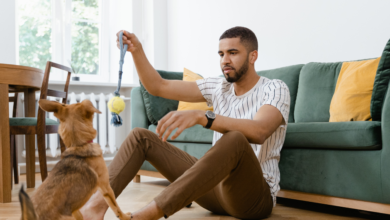Unleashing the Power of Dog Training: Effective Tips for a Well-Behaved Pup

Bringing a new puppy into your life is an exciting and rewarding experience, but it also comes with its fair share of challenges. From potty training to obedience commands, the journey to a well-behaved pup can sometimes feel like a daunting task. But fear not!
In this comprehensive guide, we’ll unlock the secrets to successful dog training, providing you with practical tips and expert advice to transform your furry friend into a model canine citizen.
1. Understanding the Basics
Before diving into the world of dog training, it’s essential to understand the fundamentals. From positive reinforcement techniques to establishing clear boundaries, we’ll explore the key principles that form the foundation of effective training methods.
By understanding your dog’s natural behaviors and motivations, you’ll be better equipped to communicate effectively and build a strong bond based on trust and mutual respect.
How to understands a dog’s natural behaviors in other to build a strong bond
Understanding a dog’s natural behaviors is crucial for building a strong bond based on trust, communication, and mutual respect. Here’s how you can decode and interpret your dog’s behaviors to foster a deeper connection:
1. Observation
Take the time to observe your dog in various situations and environments. Notice how they interact with people, other animals, and their surroundings.
Pay attention to their body language, facial expressions, and vocalizations, as these can provide valuable insights into their emotions and motivations.
2. Research
Educate yourself about canine behavior and communication. Books, articles, and reputable online resources can provide valuable information about the instincts, social structures, and communication cues that are inherent to dogs.
Understanding the natural behaviors of different breeds and individual personalities will help you interpret your dog’s actions more accurately.
3. Body Language
Dogs communicate primarily through body language, so learning to interpret their signals is essential for building a strong bond.
For example, a wagging tail doesn’t always indicate happiness; the position and speed of the wag can convey different emotions.
Similarly, a relaxed posture indicates comfort and confidence, while tense muscles may signal anxiety or fear.
4. Socialization
Expose your dog to various social situations and environments from an early age.
Positive experiences with people, other dogs, and different stimuli will help them develop confidence, resilience, and good social skills.
Socialization also enhances their ability to communicate and interact effectively with you and others.
5. Positive Reinforcement
Use positive reinforcement techniques to encourage desirable behaviors and strengthen your bond with your dog.
Reward your dog with treats, praise, and affection when they exhibit behaviors you want to encourage, such as coming when called, sitting politely, or walking nicely on a leash.
Positive reinforcement builds trust and confidence, making training sessions enjoyable and rewarding for both you and your dog.
6. Respect Boundaries
Respect your dog’s boundaries and preferences, and avoid forcing them into uncomfortable or stressful situations.
Pay attention to their body language and cues, and be mindful of their comfort level in different situations. By respecting their autonomy and individuality, you demonstrate your trust and understanding, which strengthens your bond.
7. Quality Time
Spend quality time together engaging in activities that your dog enjoys, whether it’s playing fetch in the park, going for a hike, or simply cuddling on the couch.
Regular bonding activities strengthen your connection and create positive associations between you and your dog.
8. Patience and Understanding
Building a strong bond with your dog takes time, patience, and understanding. Be patient with them as they learn and grow, and be empathetic to their needs and emotions.
By cultivating a supportive and nurturing environment, you’ll create a foundation of trust and mutual respect that forms the basis of a lifelong bond.
By understanding and appreciating your dog’s natural behaviors, you’ll forge a deep and meaningful connection built on trust, communication, and mutual respect.
This bond will enrich both your lives and bring you joy, companionship, and unconditional love for years to come.
2. Creating a Consistent Routine
Consistency is key when it comes to dog training. Establishing a consistent routine for feeding, potty breaks, and exercise not only helps prevent accidents and unwanted behaviors but also provides structure and stability for your pup.
We’ll provide you with practical tips for creating a daily schedule that meets your dog’s needs while promoting good behavior and obedience.
Creating a daily schedule tailored to your dog’s needs is essential for promoting good behavior, obedience, and overall well-being.
Here’s a step-by-step guide to help you design a balanced and structured routine
1. Establish Consistent Meal Times
Set regular mealtimes for your dog, ideally in the morning and evening. Consistency in feeding schedules helps regulate their digestion and prevents overeating.
Make sure to provide high-quality, nutritionally balanced meals appropriate for your dog’s age, breed, and activity level.
2. Schedule Potty Breaks
Take your dog outside for bathroom breaks at regular intervals throughout the day, including first thing in the morning, after meals, before bedtime, and at other key times.
Consistent potty breaks help prevent accidents indoors and reinforce good bathroom habits.
3. Incorporate Exercise and Playtime
Allocate time for physical activity and mental stimulation each day.
Depending on your dog’s age, breed, and energy level, this may include walks, runs, hikes, fetch sessions, or interactive play with toys.
Aim for at least 30 minutes to an hour of exercise per day to keep your dog physically and mentally stimulated.
4. Training and Enrichment Activities
Dedicate time for obedience training, mental enrichment, and skill-building exercises. Use positive reinforcement techniques to teach your dog basic commands, such as sit, stay, come, and leash manners.
Incorporate puzzle toys, treat-dispensing toys, and training games to keep your dog mentally engaged and challenged.
5. Provide Rest and Relaxation
Allow your dog ample time for rest and relaxation throughout the day. Create a comfortable sleeping area where they can retreat and unwind, free from distractions and noise.
Ensure they have access to fresh water and comfortable bedding for napping and downtime.
6. Socialization Opportunities
Plan regular socialization outings and interactions with other dogs, people, and new environments.
Socialization helps your dog develop confidence, resilience, and good social skills while preventing fearfulness or aggression towards unfamiliar stimuli.
Take your dog to dog parks, puppy classes, or on outings to pet-friendly stores and cafes.
7. Bonding Time with You
Make time for one-on-one bonding activities with your dog each day. This may include cuddling, grooming, practicing training exercises, or simply spending quality time together engaging in activities you both enjoy.
Building a strong bond with your dog strengthens your relationship and reinforces positive behaviors.
8. Consistency and Flexibility
Stick to your daily schedule as much as possible to provide structure and predictability for your dog. However, remain flexible and adaptable to accommodate unexpected changes or events that may arise.
Consistency is key for promoting good behavior, but flexibility allows you to meet your dog’s evolving needs and preferences.
By creating a daily schedule that incorporates these key elements, you’ll provide your dog with the structure, stimulation, and support they need to thrive.
A balanced routine promotes good behavior, obedience, and overall well-being, setting the stage for a happy and fulfilling life together.
3. Mastering Obedience Commands:
Obedience training is essential for a well-behaved pup, but it doesn’t have to be boring or frustrating. We’ll teach you how to teach your dog basic commands such as sit, stay, come, and heel using positive reinforcement techniques and reward-based training.
With patience, consistency, and plenty of praise, you’ll be amazed at how quickly your pup learns to follow your lead.
4. Addressing Behavioral Challenges
Every dog is unique, and some may present specific behavioral challenges that require extra attention and patience.
Whether it’s excessive barking, chewing, or leash pulling, we’ll provide you with practical strategies for addressing common behavioral issues and redirecting your dog’s energy into more appropriate channels.
From desensitization exercises to management techniques, we’ll help you tackle even the toughest training hurdles with confidence and compassion.
5. Fostering a Lifelong Bond
At the heart of effective dog training lies a deep and enduring bond between you and your pup. Training isn’t just about obedience—it’s also about building trust, communication, and mutual understanding.
With patience, consistency, and a whole lot of fun, you’ll create a lifelong partnership based on trust, respect, and unconditional love.
Conclusion:
Training your dog isn’t just about teaching them commands—it’s about nurturing a lifelong bond built on trust, respect, and mutual understanding. With the right approach, patience, and dedication, you can unleash the full potential of your furry friend and enjoy a lifetime of joy, companionship, and shared adventures.
So, what are you waiting for?
Let’s embark on this exciting journey together and unleash the power of dog training!



